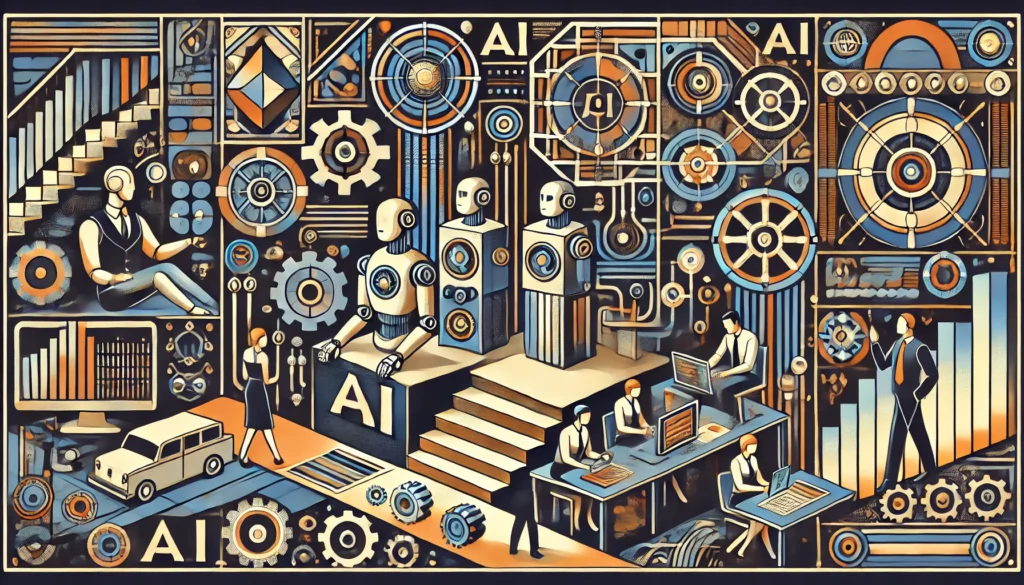From Skeptic to Strategist: Embracing AI as a Business Ally
When AI first started making waves in business, I was among those who weren’t entirely sold. I wondered, could this new tech truly add value in areas requiring insight, intuition, and experience? But over time, I started to see it differently. Just as power tools revolutionized manual work and CRMs transformed customer management, AI is proving itself to be a powerful ally in the modern business world, especially for those of us juggling strategy, client relationships, and operations.
This article takes you through my journey from skepticism to enthusiastic adoption. I’ll share how I’ve integrated AI not only to streamline processes but also to develop custom tools for everything from content generation to client engagement—tools that deliver results in real-time. We’ll explore the Four A’s framework and see how AI supports business operations across Acumen, Activities, Automation, and Attitude, highlighting practical applications and ways it makes work more efficient.
For those interested in learning how to collaborate effectively, I’ve also included a guide based on insights gained over the past months with AI as my assistant – using AI to enhance my human relationships. This article provides a glimpse into the future of business strategy—where people and AI work hand-in-hand to drive growth and innovation.
The Journey from Doubt to Acceptance

Initial Reservations About AI
When AI first became a prominent topic, I, like many, had reservations. The idea of relying on algorithms to handle key business functions—especially those involving human interactions—felt impersonal and a bit risky. My concerns mirrored historical hesitations surrounding other now-indispensable technologies. Just as there was initial resistance to adopting email over postal mail or implementing CRMs over traditional rolodexes, I questioned whether AI could truly replicate the nuanced decision-making that drives effective business strategy.
In the past, technological leaps were often met with skepticism, whether during the industrial revolution, the introduction of manufacturing bots in the 1970s, or even when power drills and impact drivers replaced manual tools. Similarly, while CRM systems gradually took over from post-it notes and rolodexes, there was hesitation to fully embrace these digital solutions. For me, AI felt like the next phase in that continuum—perhaps valuable, but maybe not essential. I would watch, learn, test and see.
Turning Point: Understanding AI’s Value
My perspective on AI shifted through hands-on experience. One turning point came when I used an AI tool to analyze client data, revealing patterns that had gone unnoticed in manual reviews. Suddenly, AI wasn’t just a “nice-to-have”—it was an invaluable resource that could unearth insights I simply couldn’t see without it.
Another eye-opener was witnessing AI’s ability to personalize communications on an impressive scale. I’d built automations for client communications before, but AI introduced a level of personalization and adaptability that made these interactions feel authentically one-on-one. The ability to segment audiences and tailor messages based on nuanced behavioral data showed me AI’s potential to enhance both efficiency and effectiveness.
As these experiences accumulated, I saw AI less as a replacement for human expertise and more as an essential partner in driving strategy forward. By treating AI as an “assistant” rather than a replacement, I found that it could amplify my team’s capabilities without diminishing the personal touch that defines our client relationships.
This journey from skepticism to reliance has fundamentally reshaped how I approach business tools and technology. AI has become a powerful ally that, like any good tool, helps us achieve more and operate better, making it an integral part of our approach to growth and client engagement.
Practical Applications of AI in Business

How AI Enhances Business Operations
AI has become a game-changer for streamlining workflows and improving decision-making processes in my business. One of the most effective uses I’ve found for AI has been in developing marketing automation bots. These bots handle client communication tasks that are critical to engagement yet typically time-consuming. For instance, they send out follow-up emails, schedule reminders, and even personalize messages based on client behavior, making every interaction feel tailored and relevant. The impact? My team and I save countless hours on manual outreach, while also seeing a noticeable increase in client responsiveness.
In addition to marketing automation, AI has been essential in client management systems. I’ve implemented tools that help us analyze client data continuously, revealing trends and insights that inform our approach. AI algorithms now help identify key client behaviors and preferences, providing valuable intelligence that guides our strategy. Instead of reacting to data after the fact, we’re able to adjust our tactics in real time based on accurate, AI-driven insights. These tools not only streamline our day-to-day tasks but also allow us to make smarter, data-informed decisions that directly contribute to growth.
AI and the Four A’s of a Contemporary Sales Machine
The integration of AI has also proven invaluable across the Four A’s of my sales strategy framework—Acumen, Activities, Automation, and Attitude:
- Acumen: AI strengthens our business acumen by providing deep insights through advanced analytics. Using AI, we’re able to tap into data from various sources, analyze trends, and make better-informed decisions. For example, AI tools help us understand market shifts, customer sentiment, and behavior patterns, which sharpens our strategic vision and allows us to stay a step ahead.
- Activities: On the activities side, AI optimizes numerous operational workflows. From lead generation to client follow-ups, AI helps streamline these activities so our team can focus on high-value interactions. The bots we’ve created also allow us to engage with more clients in less time, ensuring we’re not just touching base, but actively nurturing relationships that matter.
- Automation: AI has become central to our automation efforts, which is where it delivers the most significant gains. By automating repetitive tasks such as content distribution, lead scoring, and follow-up sequences, AI frees up my team’s time to focus on strategic thinking and creativity. This automation layer ensures that essential tasks are always completed promptly and consistently.
- Attitude: Finally, AI has had an unexpected but valuable influence on our attitude toward work. By taking over some of the heavy lifting, it has allowed us to approach projects with a more proactive and positive mindset. Rather than being bogged down by routine, manual tasks, the team is encouraged to think innovatively and focus on client success, which ultimately enhances our service quality and morale.
AI’s role in each of these areas has been transformative, not only optimizing how we operate but also shifting our mindset toward constant improvement and adaptability. The real-world applications of AI within the Four A’s show that it’s not just a tool but an integral part of our business growth strategy. By embracing these capabilities, we’re better positioned to drive sustainable success for our clients and our business alike.
AI as a Modern-Day Essential Tool

Analogies Between AI and Traditional Tools
To understand AI’s importance in business, it helps to think of it like the evolution from manual to power tools. Just as a power drill transformed construction by making tasks faster and more precise, AI has done the same for business operations. Where we once handled client communication, scheduling, and data analysis manually, AI now steps in as a powerful “drill” that speeds up these processes while enhancing accuracy. The time saved and the insights gained allow us to work smarter and focus on strategic tasks that drive growth.
A similar analogy applies when we look at how AI-powered CRMs surpass traditional methods of customer management, like rolodexes and sticky notes. In the past, managing client information relied on paper files or basic spreadsheets. Today, AI-driven CRMs offer dynamic, data-rich insights that go beyond basic record-keeping. They don’t just store contacts; they analyze interactions, track engagement, and even predict customer needs based on behavior patterns. This transformation has turned CRMs into intelligent systems that provide real-time insights, helping us personalize client interactions in a way that simply wasn’t possible with older methods.
In both cases, AI acts as the next logical step in making work not only faster but also more effective. Just as power tools became indispensable for any serious builder, AI has become essential for businesses aiming to stay competitive and efficient in today’s fast-paced landscape. By embracing AI, we’re able to communicate, move and operate at a new level, using tools that combine speed with strategic insight to deliver results that would be nearly impossible to achieve manually.
This helps small businesses attain a level of performance previously only available to large enterprises with huge resources of human capital.
Incorporating AI: A Guide to Collaboration
Over the past half-year, I’ve been actively working with AI tools like ChatGPT and gathering insights from various other assessments, including Kolbe and StrengthsFinder. Through this process, I realized something valuable—AI, combined with personal insights and client feedback, can create a deeper understanding of how to work best with one another. Recently, I decided to formalize these insights into a guide, aptly named the “Guide to Working with Joel,” which consolidates all of these learnings into a resource for collaborators, clients, and team members.
Creating this guide wasn’t just about improving my own efficiency; it was about making interactions more productive and rewarding for everyone I work with. By combining years of feedback, personality assessments, and real-world AI interaction, I’ve developed a roadmap that ensures my strengths and work style align with others’ needs, enhancing the quality and effectiveness of our collaboration.
This kind of guide doesn’t just apply to me. If you’re aiming to build more effective working relationships—whether with AI assistance or not—I recommend creating a similar framework for yourself and those around you. Combining insights from personality tests, client feedback, and direct work experiences allows you to provide clarity to others on how best to collaborate with you, improving productivity and satisfaction for all parties involved.
For those interested in seeing the specific details, I’ve linked to another blog containing the full guide to working with me. Whether you’re considering a similar project for yourself or simply looking for ways to improve team dynamics, taking a step back to understand and articulate your work style is a worthwhile investment.
Embracing AI: A Transformative Journey
Reflecting on the Journey
Stepping into the world of AI has been a journey not unlike adopting any new, transformative technology. From early doubts to realizing its value, my experience with AI mirrors what we’ve seen with countless other innovations—from power tools to CRMs—each initially met with skepticism but eventually indispensable. Embracing AI hasn’t just changed how I work; it’s shifted my perspective on the potential of technology to drive genuine growth and efficiency.
Tailoring AI for Your Business
For those still on the fence about integrating AI, I encourage you to think about how it could specifically enhance your business practices. AI isn’t a one-size-fits-all tool; it can be adapted to suit your unique needs, from streamlining routine tasks to uncovering insights that would be difficult to see otherwise. By tailoring AI to your goals, you can leverage it as a supportive assistant rather than a replacement, driving greater efficiency and better results.
Share Your AI Experiences
I’d love to hear from you. If you’ve started using AI in your business—or are considering it—share your experiences and questions. What challenges are you facing? What successes have you found? Let’s discuss the practical side of AI, exchanging insights and ideas on how it can truly enhance our work. Feel free to connect with me here!



Comments are closed, but trackbacks and pingbacks are open.